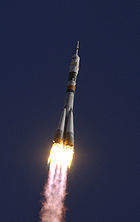Soyuz-M
This article needs additional citations for verification. (December 2009) |
| Function | Carrier rocket |
|---|---|
| Manufacturer | OKB-1 |
| Country of origin | Soviet Union |
| Size | |
| Height | 50 metres (160 ft) |
| Diameter | 10.3 metres (34 ft) |
| Mass | 300,000 kilograms (660,000 lb) |
| Stages | Two |
| Capacity | |
| Payload to LEO | |
| Mass | 6,600 kilograms (14,600 lb) |
| Associated rockets | |
| Family | R-7 (Soyuz) |
| Launch history | |
| Status | Retired |
| Launch sites | Plesetsk Sites 41/1 & 43/4 |
| Total launches | 8[1] |
| Success(es) | 8 |
| First flight | 27 December 1971 |
| Last flight | 31 March 1976 |
| Type of passengers/cargo | Zenit-4MT |
The Soyuz-M (Russian: Союз, meaning "Union"), GRAU index 11A511M was a Soviet expendable carrier rocket designed by OKB-1 and manufactured by State Aviation Plant No. 1 in Samara, Russia. It was originally built to launch crewed Soyuz 7K-VI spacecraft for the Soviet armed forces. Following the cancellation of this programme, development of the rocket continued for the Soyuz 7K-S spacecraft. After this too was cancelled, Soyuz-M development was also abandoned, and the rockets that had been completed were used to launch reconnaissance satellites.
While the exact details of the Soyuz-M are not known, it is believed to be a two-stage rocket, derived from the Soyuz. It may have been similar to the later Soyuz-U.[2] Following the cancellation of the Soyuz 7K-S, eight were launched with Zenit-4MT spacecraft.[2] The first of these launches occurred on 27 December 1971, and the last on 31 March 1976. All launches occurred from the Plesetsk Cosmodrome, six from pad 41/1 and two from pad 43/4.[1]
References
- ^ a b Krebs, Gunter. "Soyuz-M (11A511M)". Gunter's space page. Retrieved 6 May 2016.
- ^ a b Wade, Mark. "Soyuz". Encyclopedia Astronautica. Archived from the original on 2010-01-07. Retrieved 2009-04-16.

